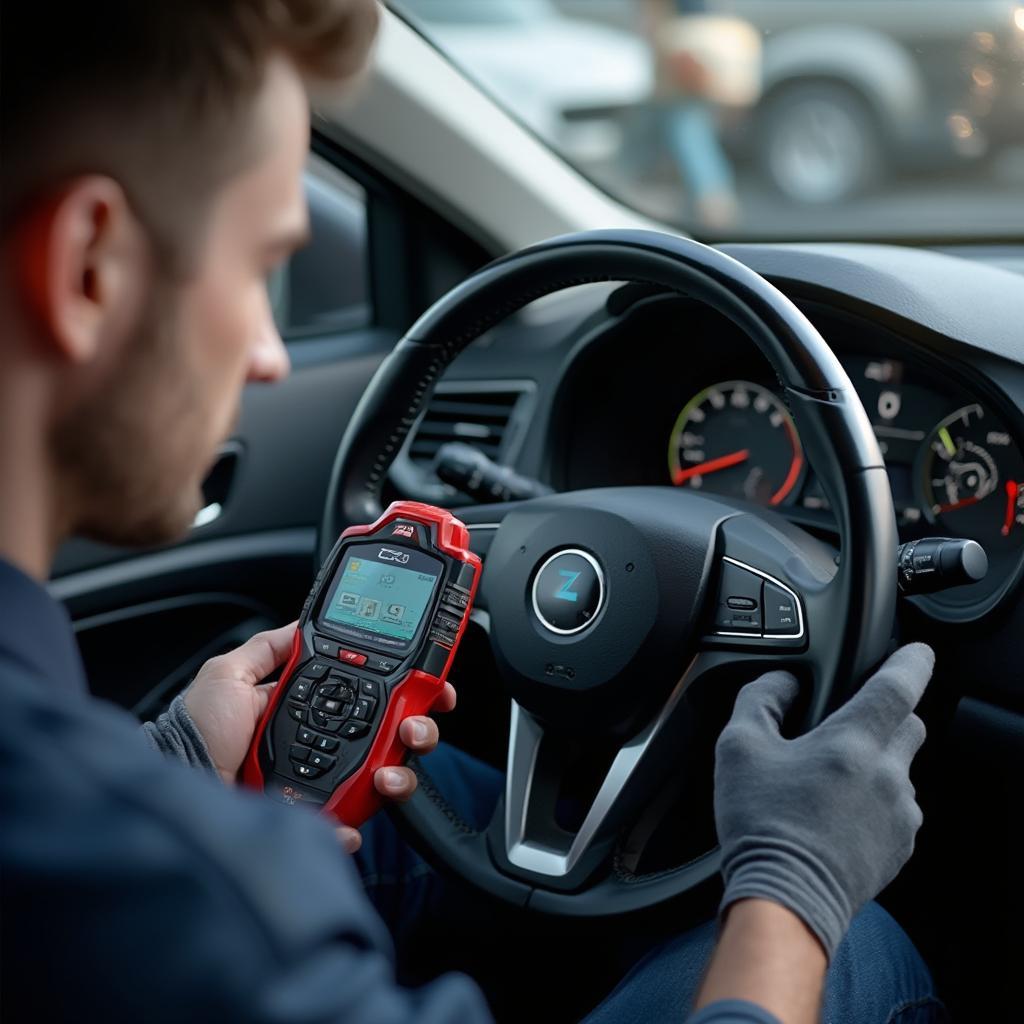An OBD2 scanner with SAS (Steering Angle Sensor) capabilities is a crucial tool for modern vehicle diagnostics and repair. It allows mechanics and car owners to identify and resolve steering-related issues, ensuring vehicle safety and optimal performance. This comprehensive guide dives deep into the world of OBD2 scanners with SAS, exploring their functionality, benefits, and how to choose the right one for your needs.
Having the ability to reset or calibrate the SAS with an obd2 scanner with sas reset offers several advantages, from improving safety features like Electronic Stability Control (ESC) to diagnosing problems that could otherwise be elusive.
Understanding the Steering Angle Sensor (SAS)
The SAS is a vital component of modern vehicle stability systems. It measures the steering wheel’s position and relays this information to the Electronic Control Unit (ECU). This data is then used by various systems, including Electronic Stability Control (ESC), Anti-lock Braking System (ABS), and Traction Control System (TCS), to ensure optimal vehicle control and stability. A malfunctioning SAS can lead to several problems, including inaccurate readings, warning lights on the dashboard, and even compromised safety features.
Why You Need an OBD2 Scanner with SAS
A standard OBD2 scanner can read and clear diagnostic trouble codes (DTCs), but it might not have the functionality to interact with the SAS directly. An OBD2 scanner with SAS capabilities goes beyond basic diagnostics. It allows you to:
- Read SAS data: Monitor the steering angle sensor’s live data stream to identify any discrepancies or unusual behavior.
- Calibrate the SAS: Perform a SAS calibration or reset after a wheel alignment, steering component replacement, or when the SAS warning light illuminates.
- Diagnose SAS-related issues: Pinpoint the root cause of SAS problems, such as a faulty sensor, wiring issues, or a misaligned steering wheel.
- Improve vehicle safety: Ensure the proper functioning of ESC, ABS, and other safety systems that rely on SAS data.
Choosing the Right OBD2 Scanner with SAS
With a wide variety of OBD2 scanners available, selecting one with the necessary SAS functionalities can be challenging. Consider the following factors:
- Vehicle Compatibility: Ensure the scanner is compatible with your vehicle’s make, model, and year. Some scanners are designed for specific vehicle brands or platforms.
- SAS Functionality: Confirm the scanner can perform the necessary SAS functions, such as reading live data, calibration, and resetting the SAS.
- Additional Features: Consider additional features like ABS bleeding, TPMS reset, and other advanced diagnostic capabilities that might be beneficial.
- User-Friendliness: Look for a scanner with a clear and intuitive interface, easy-to-understand menus, and comprehensive documentation.
- Budget: OBD2 scanners with SAS capabilities come at various price points. Set a budget and choose a scanner that fits your needs and financial constraints.
What are the advantages of obd2 steering wheel angle reset? A proper reset, achieved with compatible scanners, ensures the vehicle’s stability systems operate correctly, preventing potential safety hazards.
Common Questions about OBD2 Scanners with SAS
What does SAS stand for? SAS stands for Steering Angle Sensor.
Why is SAS calibration necessary? SAS calibration is often required after wheel alignments, steering component replacements, or when the SAS warning light illuminates.
Can any OBD2 scanner calibrate SAS? No, only OBD2 scanners specifically designed with SAS capabilities can perform SAS calibration.
How often should I calibrate my SAS? Consult your vehicle’s owner’s manual for recommended SAS calibration intervals.
Using an obd2 scanner that can calibrate brake sensor alongside SAS calibration can further enhance safety by ensuring optimal brake performance.
Conclusion
An OBD2 scanner with SAS functionality is an indispensable tool for maintaining modern vehicles. It provides the ability to diagnose and resolve SAS-related issues, ensuring proper vehicle safety and performance. By considering the factors outlined in this guide, you can choose the right OBD2 scanner with SAS to meet your specific needs. Investing in a quality OBD2 scanner with SAS can save you time and money in the long run, while also contributing to a safer and more enjoyable driving experience. Understanding obd2 steering angle and its interaction with other vehicle systems is crucial for accurate diagnosis and repair.
FAQ
- Can I use an OBD2 scanner with SAS on any car?
- What are the common symptoms of a faulty SAS?
- How much does an OBD2 scanner with SAS cost?
- Where can I buy a reliable OBD2 scanner with SAS?
- What are the benefits of owning an OBD2 scanner with SAS?
- Can I calibrate the SAS myself?
- What are the risks of driving with a faulty SAS?
For further insights, explore information regarding the obd2 scanner code p0137.
Need support? Contact us via WhatsApp: +1(641)206-8880, Email: [email protected] or visit us at 789 Elm Street, San Francisco, CA 94102, USA. Our customer support team is available 24/7.
